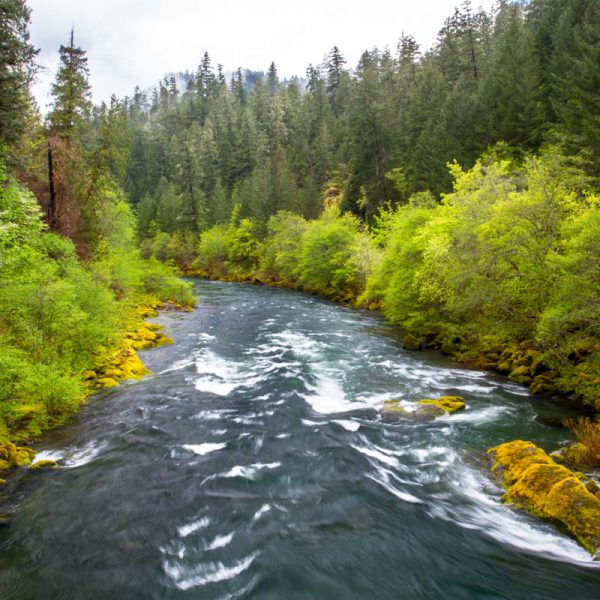The low summer flow of steelhead streams can be a limiting factor in run size and health. There is only so much accessible habitat as streams shrink in late summer. As flow diminishes, water temperature tends to increase which can limit quality habitat as well which can greatly reduce survival of rearing juveniles. This condition can also limit over-summering habitat for adult summer steelhead and spring chinook, increasing pre-spawn mortality. North Umpqua steelhead typically spend their first two years in the watershed so must endure the limits of low summer flows twice before migrating to the Pacific Ocean. In many streams, the late summer flow seems to be reduced compared to historic records. Where has all the water gone?
Recent research has shown that common forest management activities have long-term impacts on stream flows. In a 2016 paper entitled “Summer stream flow deficits from regenerating Douglas-fir forests in the Pacific Northwest, USA” two researchers from Oregon State University. Timothy Perry and Julia Jones, analyzed a 60-year record of daily stream flow from eight paired-basin experiments in the Western Cascades. These were located in the Umpqua (Coyote Creek) and several Willamette (H.J Andrews) experimental watersheds.
These areas were previously old-growth (150-500 years old) Douglas fir and western hemlock stands, prior to treatments that converted them to early stage Douglas fir plantations through different treatments, e.g. clear-cutting and various thinnings. Each treated area had an adjacent untreated control area. They found that average daily stream flow in summer (July through September) in basins with 34 to 43 year-old plantations was 50% lower than the controls. These findings were irrespective of the type of treatment and continue to this day. These treatments are comparable to most managed forests in the region. The mechanism for these differences is that young Douglas fir have a higher rate of evapotranspiration, than older trees, particularly during the typical dry summers in our region. Commercial clear-cuts also tend to be replanted at an unnatural high density, which exacerbates the problem, more trees transpire more water.
It is assumed that when these plantations mature into a structurally complex forest (in another hundred years) the stream flows will return as the trees become more efficient at evapotranspiration. Unfortunately this is unlikely happen on commercial timberlands as they are managed on a 40 to 60 year harvest rotation. The young trees are clear-cut before they have a chance to mature.
As a consequence, reduced summer stream flow may limit aquatic habitat and exacerbate stream warming. Cumulatively across the region, forest management of this type is likely having adverse impacts on stream flow and water quality in most large river basins and is having impacts to all aquatic organisms, including native fish.
The road network constructed to harvest these forests has a major impact on streams as well. Increased runoff erosion, triggered landslides, and fish passage issues at road crossings are common problems with the road network in watersheds. Another less obvious problem is the interception of ground water. Ground water provides the majority of summer stream flow in many basins once the snow pack has melted and rain is absent. Ground water is also cold (typically around 40 degrees F) which can help reduce high summer water temperatures. A road can interrupt the natural flow of groundwater when it cuts across a slope in watersheds with shallow soil and a bedrock base. This occurs either from soil compaction forcing the groundwater to the surface on the upslope side of the road or when the road-cut is so deep in the side hill that it reaches bedrock, very common on steeper slopes. Once the ground water is on the surface it either quickly runs off, reaching the stream earlier in the season, if at all, or it warms, stagnates, and evaporates.

All of this diminishes low summer flows. The signs of ground water interception are surprisingly common. The upslope ditch will be wet or moist where there is no stream near by. The upslope side of the road will be particularly lush even supporting wetland plants. In extreme cases water will flow out of the ground onto the uphill road surface as the photograph shows.
Climate change is also predicted to reduce summer flows in Pacific Northwest streams as a result of lower snow pack and warmer summers. All of this sounds like doom and gloom for our wild steelhead but there may be a silver lining. Clear-cut harvests have largely stopped on federal land in our area. The plantations from past harvests are 30 to 80 years old, right in the “sweet” spot to transpire excess water. With proper management – management with the goal of restoring the historic, natural hydrologic processes – low summer flows and water temperatures should begin to improve. What does proper management look like? Primarily it is to leave the forest alone and allow it to develop old growth characteristics. Some thinning of over-stocked plantations and reintroduction of understory tree species in monoculture plantations may help in the short term but is typically not necessary. The dense road network that facilitated harvest is no longer needed and problem roads in the mid-slope and valley bottom should be decommissioned including deep sub-soiling to un-compact the base and contouring the road cuts to their natural slope. With time and proper management, the low summer flows should increase. All of us must insist the Forest Service and BLM manage their critical watersheds in this manner.

